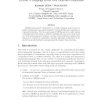1826 search results - page 52 / 366 » Using Random Forests in the Structured Language Model |
ICASSP
2009
IEEE
13 years 6 months ago
2009
IEEE
In the context of spoken language interpretation, this paper introduces a stochastic approach to infer and compose semantic structures. Semantic frame structures are directly deri...
ANLP
1994
13 years 10 months ago
1994
This paper proposes a model using associative processors (APs) for real-time spoken language translation. Spoken language translation requires (1) an accurate translation and (2) ...
IEEEIAS
2008
IEEE
14 years 3 months ago
2008
IEEE
To achieve high accuracy while lowering false alarm rates are major challenges in designing an intrusion detection system. In addressing this issue, this paper proposes an ensembl...
FASE
2010
Springer
14 years 3 months ago
2010
Springer
Abstract. Abstraction is essential in the formal specification of programs. A common way of writing abstract specifications is to specify implementations in terms of basic mathem...
MEMBRANE
2004
Springer
14 years 2 months ago
2004
Springer
LMNtal (pronounced “elemental”) is a simple language model based on graph rewriting that uses logical variables to represent links and membranes to represent hierarchies. The ...

